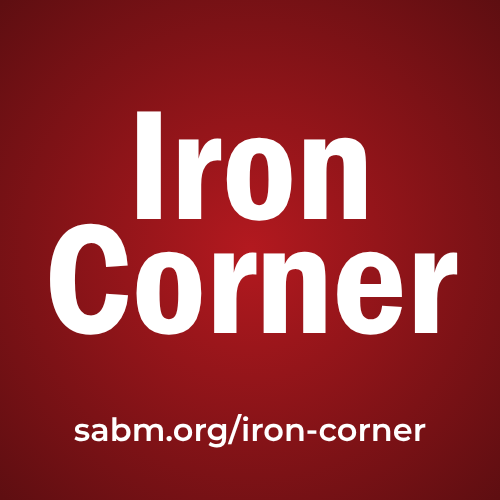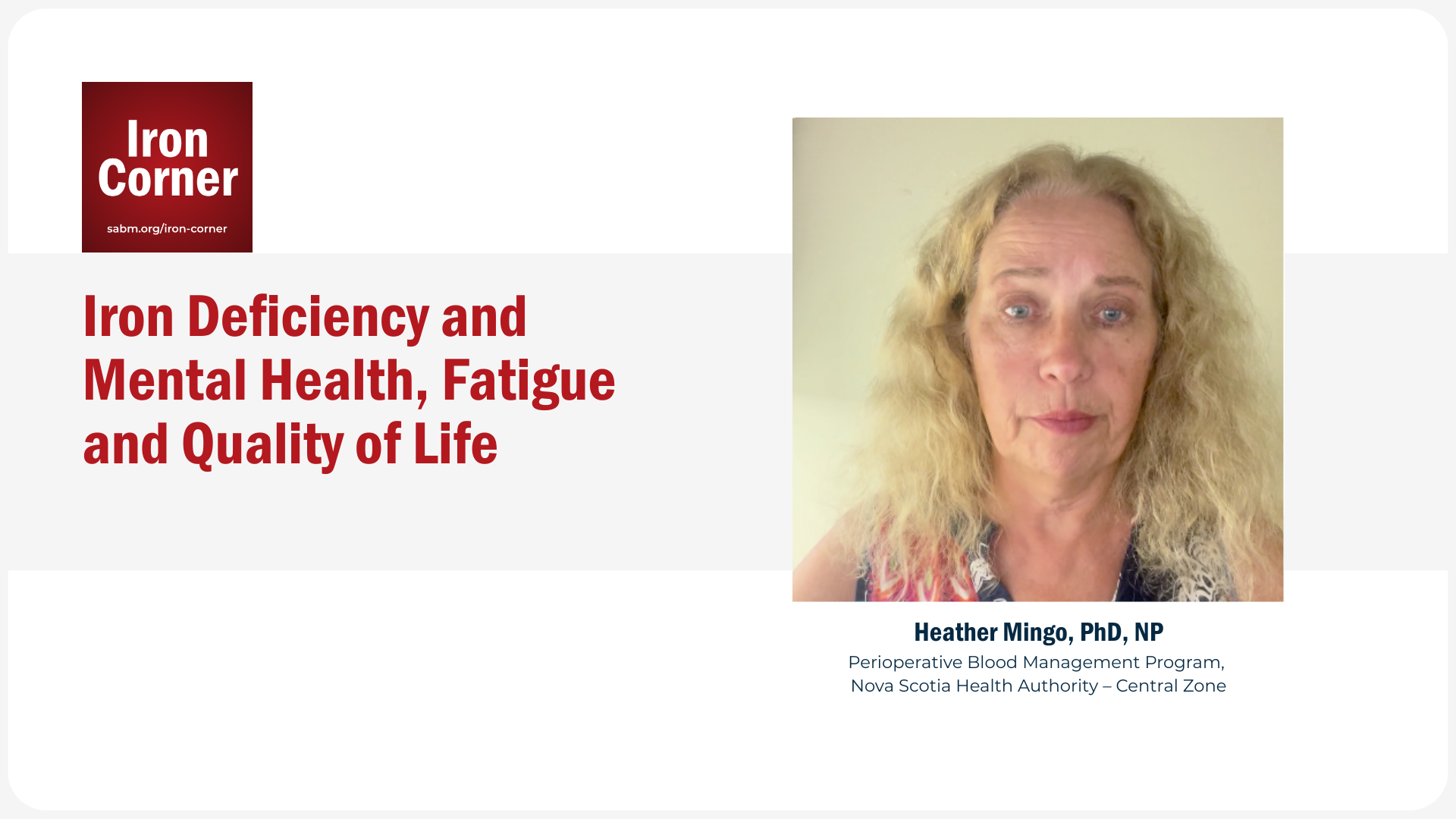|
 Overview | Diagnosis | Treatment Options | Clinical Focus Areas | Perioperative Anemia | Resources Overview | Diagnosis | Treatment Options | Clinical Focus Areas | Perioperative Anemia | Resources
Iron Deficiency and Mental Health, Fatigue and Quality of Life

Watch Video Summary by Heather Mingo, PhD, NP
SUMMARY
- Iron deficiency (ID) can present as mental health issues.
- Fatigue is one of the most common and early symptoms of iron deficiency.
- Iron deficiency has multiple impacts on quality of life (QoL).
- There are gaps and barriers in understanding women’s experience and response to iron deficiency and treatment.

Mental Health
Psychiatric Symptoms and Iron Deficiency
Iron deficiency should be ruled out in patients presenting with psychiatric concerns, especially depression, anxiety, fatigue, or sleep disturbances.
Postpartum Depression (PPD)
Studies show a strong link between IDA and PPD:
- 8 out of 10 studies found increased risk of PPD in women with iron deficiency anemia.
- 4 out of 5 studies showed a reduction in PPD risk when iron therapy was provided (Wassef et al., 2019).
Medication-Induced Deficiency
Certain psychiatric medications, including SSRIs and antipsychotics, can deplete iron or interfere with iron metabolism, potentially worsening fatigue and mood disorders.
Transgender Health Consideration
Estradiol therapy in transgender individuals may suppress the erythropoietin (EPO) axis, increasing the risk for iron deficiency. Monitoring and supplementation may be warranted in those on long-term hormone therapy.
Fatigue
Prevalence and Mechanism
Fatigue is one of the most common and early symptoms of iron deficiency—even before anemia develops. It results from reduced hemoglobin and impaired oxygen delivery to tissues.
Multisystem Burden
Fatigue is often underrecognized in chronic illnesses like renal failure, multiple sclerosis, cancer, psychiatric illness, and cardiovascular disease (Heesen et al., 2006; Smets et al., 1993; Lee et al., 2014; Lerdal et al., 2012).
Evidence for Improvement with Iron
- A meta-analysis of 18 trials found that iron supplementation improved self-reported fatigue, even if objective activity didn’t change (Houston et al., 2018).
- Oral iron was effective in reducing fatigue in menstruating women with low ferritin or mild anemia (Vaucher et al., 2012; Verdon et al., 2003).
- Dietary and supplemental iron improved vitality and mental well-being in women of childbearing age (Patterson et al., 2001).
- IV iron (such as ferric carboxymaltose) increased hemoglobin and reduced fatigue in women with IDA (Auerbach et al., 2019).
- Patients receiving IV iron experienced ≥2 g/dL hemoglobin increases in 81% at 5 weeks, compared to just 6% with placebo, with significant fatigue relief (Vadhan-Raj et al., 2014).
- However, fatigue recovery was slower with ferric carboxymaltose due to phosphate depletion (Zoller et al., 2023).
Post-CABG fatigue
- Over 50% of patients report fatigue after coronary artery bypass grafting, and 10% continue to experience symptoms after three months (Barnason et al., 2008; Rubin et al., 2004).
Quality of Life
Definition and Relevance
Health-related quality of life measures a person’s perceived physical and mental health over time. It is a critical patient-reported outcome and is significantly impacted by iron deficiency anemia (CDC, 2017).
Workplace Productivity
IDA reduces energy, attention, and performance at work. Correcting anemia improves presenteeism and overall productivity (Kronke et al., 2012).
IV Iron and QoL Improvement
- Cancer patients receiving IV iron showed significant gains in physical function and overall QoL (Ludwig et al., 2022).
- In heart failure patients, iron status was more predictive of QoL outcomes than hemoglobin levels alone (Klip et al., 2013).
- Women with heavy menstrual bleeding who were treated for IDA experienced improved mood, energy, and social functioning (Fraser et al., 2014).
Even Mild IDA Matters
- Mild iron deficiency impairs physical, emotional, and social well-being. Iron therapy has been shown to improve scores on validated scales within weeks (Manasanch et al., 2011; Sato et al., 2006).
Other Populations
- Patients with inflammatory bowel disease (IBD), even in remission, had reduced QoL when iron deficient. Correction improved fatigue and well-being (Nielsen et al., 2016).
- In chronic kidney disease (CKD), IV iron led to significant improvements in both physical and emotional health (Scott et al., 2015).
- In CKD stages G3b–G5, both anemia and iron deficiency independently reduced QoL (Yamaguchi et al., 2024).
- Pediatric IBD patients who received IV iron reported sustained improvements in energy, mood, and academic performance (Baker et al., 2020).
GI Side Effects and Newer Iron Formulations
Oral iron can cause gastrointestinal side effects that negatively impact QoL. Newer formulations and IV alternatives may reduce this burden (Cancelo-Hidalgo et al., 2013).
References
- Auerbach, M., Ballard, H., & Trout, J. R. (2019). Intravenous iron optimizes hemoglobin and minimizes fatigue: Comparative study of IV formulations in women with IDA. American Journal of Hematology.
- Baker, S. S., Baker, R. D., & Zhu, L. (2020). Intravenous iron therapy improves quality of life in pediatric IBD with iron deficiency anemia. Journal of Pediatric Gastroenterology and Nutrition, 70(4), 486–492.
- Barnason, S., Zimmerman, L., & Nieveen, J. (2008). Fatigue and its impact on recovery after coronary artery bypass surgery. American Journal of Critical Care, 17(6), 499–509.
- Cancelo-Hidalgo, M. J., Castelo-Branco, C., Palacios, S., Haya Palazuelos, J., Ciria-Recasens, M., Manasanch, J., & Pérez-Edo, L. (2013). Tolerability of different oral iron supplements: A systematic review. Current Medical Research and Opinion, 29(4), 291–303.
- CDC. (2017). Health-Related Quality of Life (HRQoL). Centers for Disease Control and Prevention. https://www.cdc.gov/hrqol/index.htm
- Fraser, I. S., Mansour, D., Breymann, C., Calaf-Alsina, J., & Schulze-Rath, R. (2014). Impact of iron deficiency and iron-deficiency anemia on women’s health. Journal of Women's Health, 24(9), 761–771.
- Heesen, C., Nawrath, L., Reich, C., Bauer, N., Schulz, H., & Gold, S. M. (2006). Fatigue in multiple sclerosis: An example of cytokine mediated sickness behaviour? Journal of Neurology, Neurosurgery & Psychiatry, 77(1), 34–39.
- Houston, B. L., Hurrie, D., Graham, J., Perija, B., Rimmer, E., Rabbani, R., ... & Zarychanski, R. (2018). Efficacy of iron supplementation in patients with non-anemic iron deficiency: A systematic review and meta-analysis. Blood Advances, 2(13), 1330–1340.
- Klip, I. T., Comin-Colet, J., Voors, A. A., Ponikowski, P., Enjuanes, C., Banasiak, W., ... & van Veldhuisen, D. J. (2013). Iron deficiency in chronic heart failure: An international pooled analysis. European Journal of Heart Failure, 15(3), 304–312.
- Kronke, K., Spies, C. D., & Scheller, B. (2012). Presenteeism and iron-deficiency anemia: Productivity and economic implications. Journal of Occupational and Environmental Medicine, 54(11), 1381–1387.
- Lee, K. A., Dziadkowiec, O., & Meek, P. (2014). Fatigue in chronic illness: Understanding the symptom. Nursing Clinics of North America, 49(3), 403–413.
- Lerdal, A., Lee, K. A., Bakken, L. N., Finset, A., & Kim, H. S. (2012). Chronic fatigue in chronic illness: Longitudinal follow-up and associated factors. Clinical Nursing Research, 21(1), 52–70.
- Ludwig, H., Van Belle, S., Barrett-Lee, P., Birgegård, G., Bokemeyer, C., Gascón, P., ... & Rusthoven, J. J. (2022). The effect of intravenous iron in cancer-related anemia: Quality of life improvements. Supportive Care in Cancer, 30(2), 1235–1243.
- Manasanch, E. E., & Smith, E. M. L. (2011). The impact of iron deficiency on functional health in mild anemia. Current Opinion in Clinical Nutrition and Metabolic Care, 14(6), 509–515.
- Nielsen, O. H., Andreasson, B., Farkas, K., & Rosenberg, R. (2016). Non-anemic iron deficiency impairs quality of life in inflammatory bowel disease. Journal of Crohn's and Colitis, 10(2), 215–220.
- Patterson, A. J., Brown, W. J., & Roberts, D. C. (2001). Dietary and supplemental iron improves fatigue and mood in women of childbearing age. The American Journal of Clinical Nutrition, 74(6), 770–775.
- Rubin, G. J., Hardy, R., & Hotopf, M. (2004). A prospective cohort study of fatigue after surgery. Journal of Psychosomatic Research, 57(6), 547–554.
- Sato, K., Fukuda, T., Hori, N., & Aoyagi, Y. (2006). Effect of oral iron on fatigue and general health in Japanese women with iron deficiency. The Japanese Journal of Clinical Pathology, 54(5), 391–397.
- Scott, L. J., McKeage, K., Keam, S. J., & Plosker, G. L. (2015). Intravenous iron therapy in chronic kidney disease patients: Impact on quality of life. Drugs & Aging, 32(2), 145–157.
- Smets, E. M., Garssen, B., Schuster-Uitterhoeve, A. L., & de Haes, J. C. (1993). Fatigue in cancer patients. Cancer, 72(3), 927–934.
- Vadhan-Raj, S., Strauss, W. E., Ford, D., Bernard, K., & Boccia, R. V. (2014). Randomized trial of IV iron vs. placebo in patients with IDA: Hemoglobin and fatigue improvement. American Journal of Hematology, 89(1), 7–12.
- Vaucher, P., Druais, P. L., Waldvogel, S., & Favrat, B. (2012). Effect of iron supplementation on fatigue in nonanemic menstruating women with low ferritin. CMAJ, 184(11), 1247–1254.
- Verdon, F., Burnand, B., Stubi, C. L. F., Bonard, C., Graff, M., Michaud, G., ... & Favrat, B. (2003). Iron supplementation for unexplained fatigue in primary care: A double blind randomized controlled trial. BMJ, 326(7399), 1124.
- Wassef, A., Nguyen, Q. D., St-André, M., & Richebé, P. (2019). Anemia and depletion of iron stores as risk factors for postpartum depression: A literature review. Journal of Psychosomatic Obstetrics & Gynecology, 40(1), 19–28. https://doi.org/10.1080/0167482X.2018.1449257
- Yamaguchi, J., et al. (2024). Anemia and iron deficiency correlate with lower QoL in Japanese patients with CKD. Nephrology Dialysis Transplantation. [In press]
- Zoller, H., Schaefer, B., Gludovacz, E., & Kurz, K. (2023). Comparative efficacy of ferric carboxymaltose and ferric derisomaltose in PHOSPHARE-IBD. Journal of Crohn’s and Colitis. https://doi.org/10.1093/ecco-jcc/jjad004
|